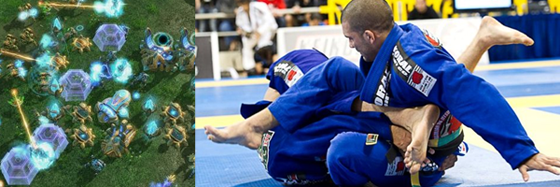We jiu-jitsu guys like to compare our art to chess, but most of my friends are more familiar with video games than thousand year old board games. So when I need to describe bjj, I usually start with “it’s pretty much like starcreft”. But I’ve never looked into it much deeper than that, so here we go.
What is the game about?
In StarCraft, two players fight each other until one of them is either destroyed or gives up. The same can be said about bjj, but admitedely also of most combat sports. The main difference is obviously that we are using our bodies to fight in bjj, whereas in StarCraft players are using a virtual civilization.
APM
APM refers to Actions Per Minute, litteraly the amount of commands (like moving, building or attacking) you give to your units while playing during a minute. Last time I checked, world classplayers average around 250 APM per match — more than 4 actions per seconds!
APM is usually considered a big factor, but having a better APM rate than your opponent doesn’t automatically makes you win…
Sounds familiar? It’s like atheletisism in bjj. It really helps to be explosive and strong but you will still get your ass kicked by a smaller opponent if he has better technique. This is something that cannot be said of every martial art.
Technique
Speaking of technique, that’s something both game have. In BJJ, it’s a fundamental part and you’ll start paying for sloppy technique very early. StarCraft has technical requirements as well — i’m thinking about stuff like dropping units from ships. I don’t know how big a factor it is regarding wins.
How do you win?
Here is the core similarity: both are real time strategy games. You cant just go out and fight without a tactic or a plan. You need a general overview of where you want to go, how you want the situation to evolve. You also need to adapt your plan as the match goes on. Once you know what your opponent wants to do, you need to find ways to counter him just as he is going to try and counter you. The speed with which you adjust your game will be a huge factor.
This opens up the psychological aspect of the game; because your enemy will adapt to what you do, you can now set up baits and traps. Jay from JayJitsu has an intresting post about chess and jiu jitsu — he asks how jiu jitsu is closer to chess than to tennis, since in all three cases you “adjust to what your opponent is doing”.

While all three games involve strategy, you can’t really bait and trap in tennis. Baiting means that you give your opponent the impression that he is in a dominant situation even though you are about to start an effective counter-attack. But there is no such thing as a perceived advantage in tennis — if your opponent is attacking you can only rely on better skills to counter him. Or how often do you see Federer offering his opponent a smash just to counter him?
The notion of style is also present in most strategic games. While tactics are often shared across players, each has his favorite approach to the game and a certain style, involving techniques he or she masters better than most other people. Being aware of your opponents style gives you an edge — being unpredicatble yourself denies that edge to your opponents.
Micro and macro managment
Micro-management is the skill of managing individual units during a battle, like backing wounded units before they die or using certain skills at the right time. Macro-management on the other hand is about th general picture, making sure that you are using your ressources well, expanding fast enough and producing units at a good rate.
There are very similar aspects in bjj; making sure you have better grips and hooks than your opponent, adjusting the pressure or the leg positions are examples of micro-management, important in a transatory situation. Macro is of course the general plan you follow, transitionning from one position to another and setting up attacks.
Maps
One key difference though is the notion of maps. In StarCraft, each game is played on a map with certain caracteristics that influence the way you play. This aspect doesn’t exist in bjj — the only place we fight is on the mats.